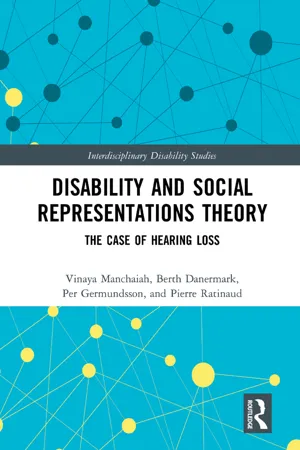Summary
Hearing loss is one of the most common chronic conditions in older adults. Age-related and noise induced types of hearing loss constitute the biggest proportions of permanent hearing loss that have no medical or surgical cure. Untreated hearing loss can result in various physical, mental, and social consequences to both the person with hearing loss and their significant others. The most commonly used management strategy for those with permanent hearing loss is hearing aids. Hearing aids have been shown to reduce the negative effects of hearing loss. However, in the Western world only one in three or one in four people with hearing loss own a hearing aid, and an even smaller number use them. In hearing healthcare literature, several studies have examined the attitude and behavior of people with hearing loss towards hearing aids; however, not much is known about the manner in which society generally views and perceives hearing loss and hearing aids. In this chapter, a summary of audiological literature on attitude towards hearing loss and hearing aids is provided, the limitations of attitude research are identified, and a case for the use of Social Representations Theory in understanding the public perception of hearing loss and hearing aids is made.
Introduction
In this section, the results of social representation studies on “hearing loss” and “hearing aids” (Manchaiah, Danermark, et al., 2015a, 2015b; Manchaiah, Ratinaud, et al., 2018b; Germundsson et al., 2018) are discussed. However, before presenting the empirical studies, in this chapter, hearing loss and hearing aids are introduced and a summary of audiological literature on attitude towards hearing loss and hearing aids is provided.
Consequences of hearing loss
Hearing loss is one of the most frequent chronic conditions in older adults (Collins, 1997). Around 466 million people (i.e., over 5% of the population) live worldwide with disabling hearing loss (World Health Organization, 2018). Age-related and noise induced types of hearing loss constitute the biggest proportions of permanent hearing loss that have no medical or surgical cure. Hearing loss can result in various physical, mental, and social consequences to both the person with hearing loss (Chia et al., 2007) and their significant others (Manchaiah, Stephens, Zhao, & Kramer, 2012; Manchaiah & Taylor, 2018). Despite these adverse consequences, only a small number of people with hearing loss seek help and adopt interventions for their hearing loss (Davis et al., 2007). Hearing loss is most often recognized as a medical problem related to body structure and body function. However, research has clearly shown the close relation between hearing loss and factors such as communication, emotions, identity, and social relations (for review see — Manchaiah & Stephens, 2013). That means that hearing loss is a multidimensional state of being and has to be addressed from a clinical perspective in a multi professional way, and in research in an interdisciplinary way.
Hearing aids as a management option for hearing loss
Hearing aids are the most commonly used management strategy by those with permanent hearing loss, and hearing aids are known to reduce the negative effects of hearing loss (Stark & Hickson, 2004). However, in the Western world only one in three or one in four people with hearing loss owns a hearing aid (Bainbridge & Ramachandran, 2014; Davis et al., 2007) and an even smaller number use them. In low- and middle-income countries, this could be as low as one in ten or one in twenty people with hearing loss. The current production of hearing aids is anticipated to meet less than 10% of global needs (World Health Organization, 2018). Moreover, various reasons such as perceived hearing disability, cost, and stigma have been linked to non-uptake and non-use of hearing aids (David & Werner, 2016; McCormack & Fortnum, 2013; Ng & Loke, 2015).
Attitude towards hearing loss
Disability have been studied using various methods or theoretical frameworks, including attitude (Saunders, Cienkowski, Forsline, & Fausti, 2005; Zheng et al., 2016), stigmatization (Erler & Garstecki, 2002), prototype (Martz et al., 2009; McCaughey & Strohmer, 2005), and Social Representations Theory (Linton, Germundsson, Heimann, & Danermark, 2013; Manchaiah, Danermark, et al., 2015a, 2015b). However, studies on attitude towards health conditions and disabilities seems to be much more frequent when compared to other approaches. Although there is no universally accepted definition, “attitude” can be defined as a settled way of thinking or feeling about someone or something. Published work on attitude suggests that it has four main components: (1) evaluative; (2) affective; (3) cognitive; and (4) behavioral (Olson & Zanna, 1993; Albarracin & Shavitt, 2018). However, it is important to note that it is challenging to measure attitude as the self-reported measures does not assess all of the dimensions listed earlier (i.e., behavioral or affective).
In the area of hearing healthcare there is growing literature on attitude to hearing aids uptake (i.e., purchase and use of hearing aids), and hearing help-seeking (Knudsen et al., 2010; Jenstad & Moon, 2011). Most studies of attitude related to hearing loss have focused on the attitude of the persons with hearing loss. Few studies have investigated the attitude of others (...
